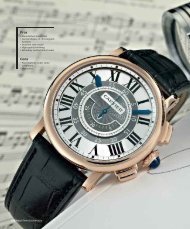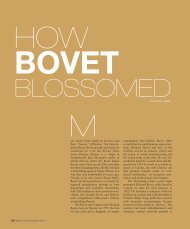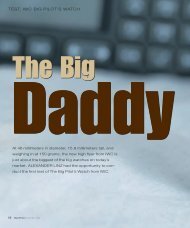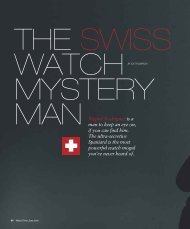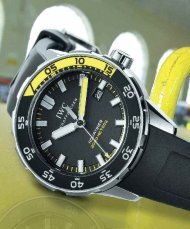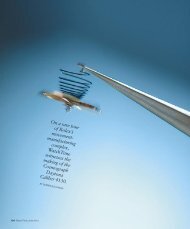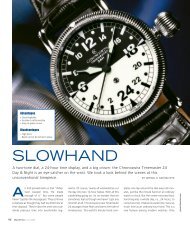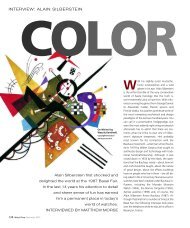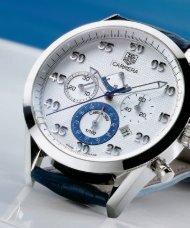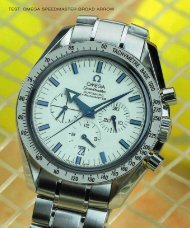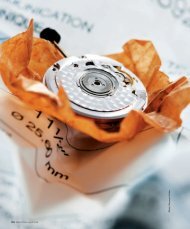WT_2004_05: ROLEX: THE STATUS SYMBOL
WT_2004_05: ROLEX: THE STATUS SYMBOL
WT_2004_05: ROLEX: THE STATUS SYMBOL
Create successful ePaper yourself
Turn your PDF publications into a flip-book with our unique Google optimized e-Paper software.
Rolex’s headquarters on Rue François-Dussaud in Geneva.<br />
rate group of components for the automatic<br />
winding mechanism can also be regarded as a<br />
trailblazing innovation. Modular architecture<br />
meant that it wasn’t necessary to disassemble<br />
the entire movement whenever the winding<br />
system required servicing. To guard against<br />
over-winding, a safety mechanism consisting<br />
of a slip-spring prevented the system from<br />
over-tightening and ultimately snapping the<br />
steel mainspring.<br />
Wilsdorf still had to market the new watch,<br />
and encountered many jewelers and watch<br />
merchants who still remembered their bad experiences<br />
with the Harwood; the first serially<br />
manufactured self-winding wristwatch. Fortunately<br />
for Wilsdorf, his was a much better<br />
<strong>2004</strong>: The Latest Models<br />
The new Datejust models<br />
for <strong>2004</strong> include (left)<br />
Ref. 116 238 in yellow<br />
gold ($17,250). Bigger<br />
hands distinguish the<br />
newcomers. The rehaut<br />
has also been updated:<br />
it’s now engraved with<br />
the brand’s name and (at<br />
the “6”) the individual<br />
case number. The same<br />
details apply for the<br />
Turn-O-Graph (right),<br />
Ref. 116 264 in stainless<br />
steel with rotating white<br />
gold bezel ($5,425).<br />
64 WatchTime October <strong>2004</strong><br />
watch in every respect, and eventually the Perpetual’s<br />
inherent excellence, coupled with<br />
well-targeted advertising campaigns, overcame<br />
any hesitations.<br />
The 15 years of the original patent protection<br />
came to an end in 1948, but Rolex still<br />
held a commanding lead over nearly all its<br />
competitors. After all, for the past decade and<br />
a half, rotor winding and other refinements in<br />
Rolex’s Perpetual had been off limits to them.<br />
Only after 1948 were competitors permitted<br />
to introduce their own systems. Rolex wanted<br />
to debut a date display watch to mark the<br />
firm’s 40th birthday in 1945. The Datejust (caliber<br />
740) was a world’s first, becoming an archetype<br />
that would influence the technology<br />
Four decades of continuity: André J. Heiniger<br />
(1921-2000) led Rolex from 1963 to 1992,<br />
when his son Patrick Heiniger took the reins.<br />
and appearance of generations of subsequent<br />
watches. The watch’s name was carefully selected:<br />
“Date” is self-explanatory, while “Just”<br />
stands for “just in time.” And this means that<br />
the date display advances to show the next<br />
day’s date without delay at midnight. The<br />
watch was the world’s first fully water-resistant<br />
men’s wristwatch with automatic rotor winding,<br />
central seconds, and window-type date<br />
display whose accurate rate was verified by an<br />
official chronometer certificate.<br />
The Datejust featured a central secondshand<br />
and a readily legible date display inside a<br />
window at the “3,” a location chosen for a<br />
very good reason: most people wear a wristwatch<br />
on their left wrist, so the date display at<br />
the “3” is the first indicator that comes into<br />
view when the timepiece peeks out from under<br />
your shirt cuff.<br />
WatchTime would like to thank Wempe<br />
Jewelers for granting us permission to<br />
reprint portions of Gisbert L. Brunner’s upcoming<br />
book on Rolex.



